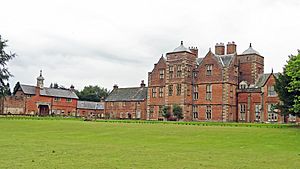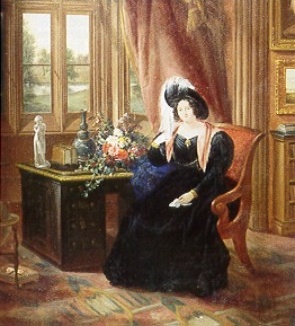Kiplin Hall facts for kids
Quick facts for kids Kiplin Hall |
|
|---|---|

The west front of Kiplin Hall,
viewed from the lake |
|
| Location | Kiplin, North Yorkshire, England |
| Area | Vale of Mowbray |
| Built | 1622–1625 |
| Architectural style(s) | Jacobean architecture |
| Type | Cultural and arts |
| Criteria | i |
| Designated | 29 January 1953 |
| Reference no. | 1315476 |
| Country | England |
| Region | Europe and North America |
| Extensions | 1720s, 1820s |
|
Listed Building – Grade I
|
|
| Reference no. | 1226284 |
Kiplin Hall is a beautiful historic house in Kiplin, North Yorkshire, England. It was built in the Jacobean style, which was popular in the 1600s. The house is a Grade I listed building, meaning it is a very important and protected site.
Today, Kiplin Hall is a museum and art gallery. It tells the story of the families who owned it over hundreds of years. The Hall is located in a peaceful area called the Vale of Mowbray, near the River Swale.
Contents
The Beginning of Kiplin Hall
Land Before the Hall
Long ago, the land where Kiplin Hall stands was owned by Easby Abbey, a local monastery. In the 1500s, during a time of religious change called the Reformation, King Henry VIII took control of many church lands. This event was known as the Dissolution of the Monasteries. After this, the Kiplin land was passed on to noble families.
A New House is Built
The story of Kiplin Hall as we know it begins in the 1620s. A man named George Calvert, 1st Baron Baltimore built the house between 1622 and 1625. He was an important figure who later founded the American colony of Maryland.
The house was first built as a hunting lodge. It was made of red brick with a cool diamond pattern made from darker blue-black bricks. A unique feature of the house was its four towers. Instead of being at the corners, they were in the middle of each wall. Each tower was topped with a special curved dome called an ogee dome.
Changes in the 18th Century
In 1722, the Hall was sold to Christopher Crowe for £7,000. Crowe was a wealthy British official who had worked in Italy. He found the 100-year-old house wasn't very comfortable, as the Calvert family had never actually lived there.
Crowe decided to make big changes. He added a grand staircase, new fireplaces, and a wing for servants. He also bought more land, making the Kiplin estate much larger.
The Hall in the 19th Century
In 1817, the Hall came into the hands of Sarah Crowe and her husband, John Carpenter, 4th Earl of Tyrconnell. They wanted to update the house again. In 1819, they hired an architect to add a new wing to the south. This room was built in the popular Gothic style.
Sarah and John had no children to inherit the Hall. When Sarah died in 1868, she left the estate to a cousin of her husband, Captain Walter Cecil Talbot. However, there were some strange conditions. To inherit the Hall, Talbot had to change his last name to Carpenter. He also had to promise to be a Protestant and have his faith checked by priests every seven years.
Talbot agreed to the conditions and moved into the Hall in 1887. He made his own changes, adding another floor to the Gothic-style room and turning it into a grand library. His wife, Beatrice, was a fan of the Arts and Crafts movement, and you can still see beautiful items from this style in the Hall today.
The 20th Century and a World at War
A Time of Decline
When Admiral Talbot (he was later promoted) died in 1904, his daughter Sarah inherited the Hall. She and her husband never lived at Kiplin. They rented it out and sold off much of the estate's land. For many years, the Hall began to fall into decline.
Bridget Talbot Saves the Hall
In 1937, Sarah's cousin, Bridget Elizabeth Talbot, became a co-owner. Bridget had happy childhood memories of Kiplin and wanted to save it. She was a remarkable woman. During the First World War, she worked with the Red Cross in Italy and was awarded a medal for her bravery. She also invented a waterproof flashlight for life jackets that saved many sailors' lives during the Second World War.
During World War II, the government took over Kiplin Hall for military use. The Royal Air Force used it to store weapons for nearby airfields. Some rooms were turned into apartments for officers.
After the war, Bridget tried for years to get the National Trust to take over the Hall, but they were not interested at the time.
The Kiplin Hall Trust
Bridget was determined to preserve the Hall for the future. In 1968, she created the Kiplin Hall Trust. The Trust's job is to protect the Hall and its grounds for the benefit of the nation. When Bridget died in 1971, she left everything inside the Hall to the Trust, which still runs it today.
Kiplin Hall Today
Thanks to a lot of hard work and restoration, Kiplin Hall is now open for everyone to visit. It offers a fascinating look at 400 years of life in North Yorkshire. There are exhibits about the Calvert family's connection to Maryland, USA, and the other families who called Kiplin home.
The Hall also works with universities. Students from the University of Maryland, Washington College, and the University of South Carolina come to Kiplin to study architecture, literature, and history.
In 2012, Kiplin Hall won two Hudson's Heritage Awards, including one for being England's "Hidden Gem."
See also
- Grade I listed buildings in North Yorkshire (district)
- Listed buildings in Kiplin
Images for kids





